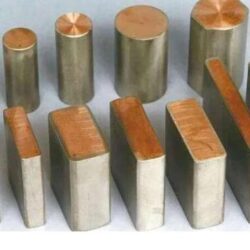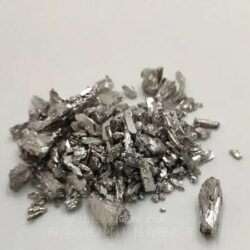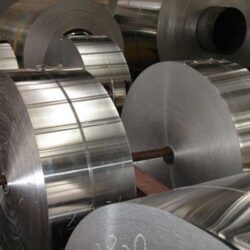1060 aluminium alloy is an aluminium-based alloy in the “commercially pure” wrought family (1000 or 1xxx series). It is fundamentally very similar to 1050 aluminium alloy, with the difference coming down to 0.1% aluminium by weight. However, while both 1050 and 1060 are covered by the same ISO standard, they are covered by different ASTM standards.
As a wrought alloy, it is typically formed by extrusion or rolling. It is commonly used in the electrical and chemical industries, on account of having high electrical conductivity, corrosion resistance, and workability. It has low mechanical strength compared to more significantly alloyed metals. It can be strengthened by cold working, but not by heat treatment.
Alternate designations include Al99.6 and A91060. It is described in the following standards:[2]
ASTM B 209: Standard Specification for Aluminium and Aluminium-Alloy Sheet and Plate
ASTM B 210: Standard Specification for Aluminium and Aluminium-Alloy Drawn Seamless Tubes
ASTM B 211: Standard Specification for Aluminium and Aluminium-Alloy Bar, Rod, and Wire
ASTM B 221: Standard Specification for Aluminium and Aluminium-Alloy Extruded Bars, Rods, Wire, Profiles, and Tubes
ASTM B 483: Standard Specification for Aluminium and Aluminium-Alloy Drawn Tube and Pipe for General Purpose Applications
ISO 6361: Wrought Aluminium and Aluminium Alloy Sheets, Strips and Plates
Chemical Composition
The alloy composition of 1060 aluminium is:
Aluminium: 99.6% min
Copper: 0.05% max
Iron: 0.35% max
Magnesium: 0.03% max
Manganese: 0.03% max
Silicon: 0.25% max
Titanium: 0.03% max
Vanadium: 0.05% max
Zinc: 0.05% max
Alloy 1060 is a relatively low strength, high purity alloy with a 99.6% minimum aluminum content. It is noted for its excellent welding characteristics and formability along with good corrosion resistance. It has excellent forming capability by cold or hot working with commercial techniques and may be welded by standard commercial methods.
The entire 1xxx alloy group displays excellent forming, welding, brazing and finishing characteristics, and can easily be impacted, cold drawn, deep drawn and bent into various configurations. The characteristics of alloy 1060 make it ideal for chemical and food handling equipment, as well as for food, pharmaceutical and liquid containers.
In addition to alloy 1060, common alloys in this series available from some Hydro locations include 1050, 1100 and 1350, all of which can be extruded as profiles, rod, bar and tubing:
Alloy 1050 is known for its good corrosion resistance, formability, weldability, ductility and highly reflective finish. It’s a popular grade for general sheet metal work where moderate strength is required. Alloy 1050 is typically used for food industry containers, architectural flashings, cable sheathing and chemical process plant equipment.
Alloy 1100, although slightly stronger than alloy 1060, shares some of the same applications, plus fin stock, spun hollowware, impacted fire extinguisher bottles and tubing. This alloy contains slight additions of silicon, iron, and copper for strength.
Alloy 1350 is used primarily for electrical conductors, and -H111 temper exhibits the highest electrical conductivity of all extruded aluminum conductor grades, meeting or exceeding 61.0% IACS.
Wrought aluminum alloy 1060
(submitted by the website administration)
| Wrought aluminum alloy 1060 | ||||
| Chemical composition: Si=0.25%, Fe=0.35%, Al = 99.6% min | ||||
| Property | Value in metric unit | Value in US unit | ||
| Density | 2.705 *10³ | kg/m³ | 169 | lb/ft³ |
|---|---|---|---|---|
| Modulus of elasticity | 69 | GPa | 10000 | ksi |
| Thermal expansion (20 ºC) | 23.6*10-6 | ºCˉ¹ | 13.1*10-6 | in/(in* ºF) |
| Specific heat capacity | 900 | J/(kg*K) | 0.215 | BTU/(lb*ºF) |
| Thermal conductivity | 231 | W/(m*K) | 1600 | BTU*in/(hr*ft²*ºF) |
| Electric resistivity | 2.81*10-8 | Ohm*m | 2.81*10-6 | Ohm*cm |
| Tensile strength (annealed) | 69 | MPa | 10000 | psi |
| Yield strength (annealed) | 28 | MPa | 4000 | psi |
| Elongation (annealed) | 43 | % | 43 | % |
| Shear strength (annealed) | 48 | MPa | 7000 | psi |
| Fatigue strength (annealed) | 21 | MPa | 3000 | psi |
| Hardness (annealed) | 19 | HB | 19 | HB |
| Tensile strength (H16) | 110 | MPa | 16000 | psi |
| Yield strength (H16) | 103 | MPa | 15000 | psi |
| Elongation (H16) | 8 | % | 8 | % |
| Shear strength (H16) | 69 | MPa | 10000 | psi |
| Fatigue strength (H16) | 45 | MPa | 6500 | psi |
| Hardness (H16) | 30 | HB | 30 | HB |
| Annealing temperature | 343 | ºC | 650 | ºF |
Application:
1060 aluminium alloy is very similar to 1050 aluminium alloy, the former has 99.60% aluminum and the latter has 99.70%, which means the difference is only 0.1% aluminum by weight. Both these two alloy products are covered by the same ISO standard but different ASTM standards. They have almost the same characteristics and applications.
Just like all 1xxx members, aluminum 1060’s machinability is poor, and does not harden by heat treatment (but it is possible to be annealed after cold working), also it is not typically used for high strength and high-pressure applications as it still belongs to pure aluminum.
It has excellent weldability and formability, actually the 1xxx series aluminum alloys have the most excellent weldability and formability which make them are suitable for many applications. 1060 aluminum alloy can be used by standard commercial methods for welding and it has strong corrosion resistance characteristics.
Based on its characteristics, 1060 aluminum alloy are widely used for products which have lower requirement for strength, such as reflector, billboard, decoration, kitchen wares, lamp holder, electric elements, chemical equipment, also because of the strong corrosion resistance characteristics, it can be used for the chemical storage, railroad tank cars and other equipment.
As a leading aluminum product provider, Aluminium Mart provides high quality 1060 aluminum alloy in different forms, including aluminum sheet, coil, plate, checkered plate, and etc. in order to meet all of your requirements.
The difference between 1060 aluminum plate and 1070 aluminum
1060 aluminum plate and 1070 aluminum plate are pure aluminum alloy, one aluminum content is 97%, one is 96% mostly pure aluminum series, 1 series, the main one is that the 1070 alloy aluminum plate is better than the 1060 aluminum plate when doing the 0 state. The reason is because the higher the aluminum content, the softer the material.
1060 aluminum sheet processing strengthening is also called cold work hardening, which is cold deformation processing of metal materials below recrystallization temperature, such as forging, calendering, drawing, stretching, etc. When cold deformation, the internal dislocation density of the metal increases, and they are intertwined and Form a cellular structure that hinders dislocation motion. The greater the degree of deformation, the more serious the dislocation entanglement, the greater the deformation resistance and the higher the strength. The degree of strengthening after cold deformation varies with the degree of deformation, the deformation temperature of the 1060 pure aluminum plate, and the nature of the material itself. When the same material is cold-deformed at the same temperature, the greater the degree of deformation, the higher the strength and the lower the plasticity. Solid solution strengthened aluminum plate
The addition of certain alloying elements to the pure aluminum 1060 hot-rolled aluminum sheet to form an infinite solid solution or a finite solid solution not only achieves high strength, but also achieves excellent plasticity and good press workability. The alloying elements commonly used for solid solution strengthening in general aluminum alloys are elements such as copper, magnesium, manganese, zinc, silicon, and nickel. Generally, the alloying of aluminum forms a limited solid solution, and binary alloys such as Al-Cu, Al-Mg, Al-Zn, Al-Si, and Al-Mn form a limited solid solution, and both have a large limit solubility. Large solid solution strengthening effect 1060 pure aluminum plate.
1070 aluminum plate has the characteristics of high plasticity, corrosion resistance, good electrical conductivity and thermal conductivity, but its strength is low, it is not strengthened by heat treatment, and its machinability is not good. It can accept contact welding and gas welding. Many advantages are used to manufacture some structural parts with specific properties, such as gaskets and capacitors made of aluminum foil, electronic tube isolation nets, wire and cable protective covers, nets, cores and aircraft ventilation system parts and decorative parts.


